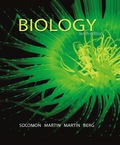
EBK BIOLOGY
10th Edition
ISBN: 8220100474729
Author: Martin
Publisher: Cengage Learning US
expand_more
expand_more
format_list_bulleted
Concept explainers
Question
Chapter 27.3, Problem 2C
Summary Introduction
To determine: The differences between megaphylls and microphylls.
Introduction: Seedless vascular plants are differentiated into true roots, stems, and leaves. These members possess well-developed vasculature for water and food transport. Seedless vascular plants possess two types of true leaves called microphylls and megaphylls. Microphylls are small sized leaves and megaphylls are large sized leaves.
Expert Solution & Answer
Trending nowThis is a popular solution!

Students have asked these similar questions
What are Clathrin coated vesicles and what is their function?
How is a protein destined for the Endoplasmic Reticulum (ER), imported into the ER? Be concise.
Find out about the organisations and the movements aimed at the
conservation of our natural resources. Eg Chipko movement and Greenpeace.
Make a project report on such an organisation.
Chapter 27 Solutions
EBK BIOLOGY
Ch. 27.1 - Discuss some environmental challenges of living on...Ch. 27.1 - Name the green algal group from which plants are...Ch. 27.1 - Prob. 1CCh. 27.1 - Prob. 2CCh. 27.1 - Prob. 3CCh. 27.1 - Prob. 4CCh. 27.2 - Summarize the features that distinguish bryophytes...Ch. 27.2 - Name and briefly describe the three phyla of...Ch. 27.2 - Describe the life cycle of mosses and compare...Ch. 27.2 - Prob. 1C
Ch. 27.2 - How are mosses, liverworts, and hornworts similar?...Ch. 27.3 - Discuss the features that distinguish seedless...Ch. 27.3 - Name and briefly describe the two phyla of...Ch. 27.3 - Describe the life cycle of ferns and compare their...Ch. 27.3 - Compare the generalized life cycles of homosporous...Ch. 27.3 - Prob. 1CCh. 27.3 - Prob. 2CCh. 27.3 - Which of the following are parts of the sporophyte...Ch. 27.3 - Why are whisk ferns and horsetails now classified...Ch. 27.3 - How does heterospory modify the plant life cycle?Ch. 27 - Plants probably descended from a group of green...Ch. 27 - Which of the following is not a characteristic of...Ch. 27 - In plant life cycles, (a) the first products of...Ch. 27 - The bryophytes (a) include mosses, liverworts, and...Ch. 27 - The waxy layer that covers aerial parts of plants...Ch. 27 - Prob. 6TYUCh. 27 - Prob. 7TYUCh. 27 - Know and Comprehend 8. The green,...Ch. 27 - Prob. 9TYUCh. 27 - Know and Comprehend 10. These plants have...Ch. 27 - Know and Comprehend 11. These plants have hollow,...Ch. 27 - Know and Comprehend 12. Which of the following...Ch. 27 - Apply and Analyze 13. VISUALIZE Draw a simple...Ch. 27 - Evaluate and Synthesize 14. EVOLUTION LINK How may...Ch. 27 - Evaluate and Synthesize 15. INTERPRET DATA...Ch. 27 - Evaluate and Synthesize 16. EVOLUTION LINK Where...
Knowledge Booster
Learn more about
Need a deep-dive on the concept behind this application? Look no further. Learn more about this topic, biology and related others by exploring similar questions and additional content below.Similar questions
- What are biofertilizers and mention the significancearrow_forwardPCBs and River Otters: Otters in Washington State’s Green-Duwamish River have high levels of polychlorinated biphenyls (PCBs) in their livers. PCBs can bind to the estrogen receptors in animals and disrupt the endocrine system of these otters. The PCBs seem to increase the estrogen to androgen ratio, skewing the ratio toward too much estrogen. How would increased estrogen affect the river otter population? Based on your reading of the materials in this unit, what factors can affect fertility in humans? Explain how each of the factors affecting human fertility that you described can disrupt the human endocrine system to affect reproduction.arrow_forwardOther than oil and alcohol, are there other liquids you could compare to water (that are liquid at room temperature)? How is water unique compared to these other liquids? What follow-up experiment would you like to do, and how would you relate it to your life?arrow_forward
- Selection of Traits What adaptations do scavengers have for locating and feeding on prey? What adaptations do predators have for capturing and consuming prey?arrow_forwardCompetition Between Species What natural processes limit populations from growing too large? What are some resources organisms can compete over in their natural habitat?arrow_forwardSpecies Interactions Explain how predators, prey and scavengers interact. Explain whether predators and scavengers are necessary or beneficial for an ecosystem.arrow_forward
- magine that you are conducting research on fruit type and seed dispersal. You submitted a paper to a peer-reviewed journal that addresses the factors that impact fruit type and seed dispersal mechanisms in plants of Central America. The editor of the journal communicates that your paper may be published if you make ‘minor revisions’ to the document. Describe two characteristics that you would expect in seeds that are dispersed by the wind. Contrast this with what you would expect for seeds that are gathered, buried or eaten by animals, and explain why they are different. (Editor’s note: Providing this information in your discussion will help readers to consider the significance of the research).arrow_forwardWhat is the difference between Uniporters, Symporters and Antiporters? Which of these are examples of active transport?arrow_forwardWhat are coupled transporters?arrow_forward
arrow_back_ios
SEE MORE QUESTIONS
arrow_forward_ios
Recommended textbooks for you
 Biology (MindTap Course List)BiologyISBN:9781337392938Author:Eldra Solomon, Charles Martin, Diana W. Martin, Linda R. BergPublisher:Cengage Learning
Biology (MindTap Course List)BiologyISBN:9781337392938Author:Eldra Solomon, Charles Martin, Diana W. Martin, Linda R. BergPublisher:Cengage Learning
 Biology: The Dynamic Science (MindTap Course List)BiologyISBN:9781305389892Author:Peter J. Russell, Paul E. Hertz, Beverly McMillanPublisher:Cengage Learning
Biology: The Dynamic Science (MindTap Course List)BiologyISBN:9781305389892Author:Peter J. Russell, Paul E. Hertz, Beverly McMillanPublisher:Cengage Learning Biology 2eBiologyISBN:9781947172517Author:Matthew Douglas, Jung Choi, Mary Ann ClarkPublisher:OpenStax
Biology 2eBiologyISBN:9781947172517Author:Matthew Douglas, Jung Choi, Mary Ann ClarkPublisher:OpenStax

Biology (MindTap Course List)
Biology
ISBN:9781337392938
Author:Eldra Solomon, Charles Martin, Diana W. Martin, Linda R. Berg
Publisher:Cengage Learning




Biology: The Dynamic Science (MindTap Course List)
Biology
ISBN:9781305389892
Author:Peter J. Russell, Paul E. Hertz, Beverly McMillan
Publisher:Cengage Learning

Biology 2e
Biology
ISBN:9781947172517
Author:Matthew Douglas, Jung Choi, Mary Ann Clark
Publisher:OpenStax
Phylogeny and the Tree of Life; Author: Professor Dave Explains;https://www.youtube.com/watch?v=KLMn4XwS8Tw;License: Standard YouTube License, CC-BY